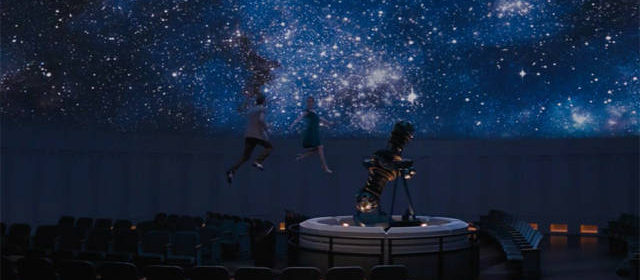La La Land

La La Land has recently enjoyed great critical success with its dominant performance at the Golden Globes. In my opinion, this movie deserves every form of recognition it receives. The film was not only visually and musically dazzling, but also dealt deeply with its themes of artistry and integrity.
When it comes to musicals, I feel that the general population is divided into two camps: one which expresses excitement and delight at the prospect of bursting into song, and the other which is more inclined to roll their eyes and complain about an excess of cheese splattered across all the musical numbers. Although I tend to fall into the former group, I can certainly see why many musicals have earned the label of “cheesy,” and why they might not be seen as serious films.
I think that La La Land, however, accomplishes an impressive feat, in that it delivers fun and abundant joy to its audience, while still feeling organic and retaining its seriousness. I think it could even be said that La La Land has revived or is in the process of reviving the movie-musical genre. And it does so by reaching into the past. Throughout, the film pays tribute to classic musicals, including a couple of scenes that seemed to me directly reminiscent of Singin’ in the Rain. As well, this focus on the past is present in the interests of the two main characters, beautifully embodied by Emma Stone and Ryan Gosling. Stone plays an aspiring actress with an appreciation for classic films like Casablanca. Gosling, on the other hand, is a jazz pianist inspired by the “greats,” rather than the novelty and artificiality of synthesized music. The whole movie is also infused with the feel of Old Hollywood, from the choreography to the costumes and sets.
One line in particular stayed with me in this regard. When a singer who is enthusiastic about the trajectory of modern jazz becomes frustrated with Gosling’s character, he says: “How are you going to be a revolutionary if you’re such a traditionalist?” The importance of tradition and its uncertain fate in a “progressive” world is one of the key themes in the film, which contributed to its organic nature and lifted it above the typical trope of the “struggling artist.” The plight of the artist is not merely a struggle to “make it,” but to maintain his or her artistic integrity in the process of doing so.
For Gosling and Stone, art is not about novelty for novelty’s sake, but truth. And this earnest search for truth is best represented by an interweaving of the various reflections of truth throughout our communal past. So often I think the emphasis on novelty in art comes from a false assumption about progress. Under this view, all things, including art, are continually getting better. Yet this, of course, is not necessarily true, and only makes us complacent, preventing us from thinking critically about the merit or goodness of what we encounter. Instead of endorsing this view, the movie expresses the richness and beauty of our shared heritage, and reflects on the necessity of authenticity in true art. This search was displayed by both Gosling and Stone’s characters and was mirrored by the movie as a whole, which was as authentic as well as sincere in its methods.
The music in the film is wonderful, and interwoven throughout in a way that does not feel overly contrived. One thing I particularly liked was the way the main melodic theme was repeated and varied frequently, like the structure of a piece of classical music. The filmography, too, was stunning, and I appreciated how deliberately stylized it was, with carefully framed shots and orchestrated movements. At times it did feel almost transcendent in its visual exploration of love and creativity, including a number of cleverly constructed montages which captured perfectly the beauty and even irreverence of dreams.
As an artist, I found this movie quite moving, and it resonated with me on a personal level. However, I think that anyone who goes into this movie with an openness and willingness to follow its unpredictable narrative turns and timelines will find it an enriching experience. It is refreshing to see a movie that not only revolves around creativity, but also sets out to tell its story earnestly, without descending into cynicism; a movie that affirms the enduring powers of both love and hope, and does so without either sarcasm or schmaltz.
The exploration of the relationship between Goslin and Stone encompasses the little, ordinary moments of life, and does so in a way which exposes their beauty and complexity. Ultimately, love as depicted in the movie is revealed as self-sacrificing, a desire for the welfare of the other. Above all, love seeks the good of its subject, and is not able to rest or be content if the other is unhappy, living inauthentically, or abandoning their own dreams. This is what made the film’s ending so triumphant, despite a bittersweet strain in its final notes, and made me think about its story long after the metaphorical curtain had fallen. (Confession: I have since listened to the soundtrack more than twice).